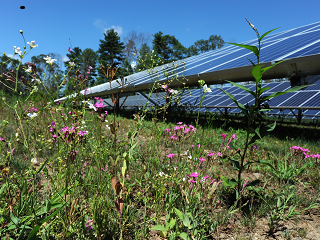This article originally appeared on the website Get Blogo, under the title Green Development LLC’s Responsible Solar Development: The Cultivation of Pollinator Meadows.
Improvements in solar panel technology have drastically cut costs of creating green energy, proving that solar and wind farms can be viable alternatives to fossil fuels if developed responsibly. For the past five years, Green Development LLC has included pollinator meadows as part of its standard solar development practices, as detailed below, to support native species, contribute to carbon sequestration, improve soil quality, and reduce long-term maintenance costs.
What is Pollinator-Friendly Solar Development?
Many parties object to solar energy out of a concern for the destruction of the natural habitats that support native wildlife, and the replacement of those habitats with gravel. It does not have to be this way, but the solution far exceeds the cost of standard gravel or turf ground covers, a price that many solar developers are not willing to pay.
Green Development LLC, a green energy developer, and other companies that care deeply about attracting key pollinators, like birds, bees, and Monarch butterflies, can spend $600-$700 or more per acre for special seed mixes that are customized by geography.
While it is true that solar developers must often remove trees from solar development sites that are ideal in terms of proximity to grid interconnections and peak sunlight exposure, replacement with solar meadows can actually improve habitats for many native species, especially if the trees have been damaged by insects or fires, or are in the process of dying.
Increased Awareness of the Importance of Pollinator-Friendly Solar Development
Green Development LLC recognized the importance of pollinator meadows several years ago, planting its first one in 2016 at the Kingstown II solar project in Richmond, RI. Since that time, it has become a standard component of all suitable solar and wind sites. For each project, Green Development partners with plant experts to ensure that the mix includes an appropriate blend of native grasses, shrubs, and wildflowers for the area. For the wind turbine project in Coventry, RI, the mix was designed to support the native birds, bees, butterflies, and rabbits that inhabited the area.
This is not a new practice. In fact, pollinator-friendly solar has been common in Europe for many years. Eight states in the U.S. recently established certification and incentive programs for solar developers committed to sustaining native species, according to the Clean Energy States Alliance and the Clean Energy Extension at the University of Massachusetts: Minnesota, Maryland, South Carolina, Vermont, New York, Illinois, Michigan, and Massachusetts. It is important to note that Green Development LLC took the initiative to consult with native plant experts and build its first pollinator-friendly solar project over five years ago, without the benefit of local legislation and certification programs.
Pollinator Meadows Have Benefits Beyond Native Species Support
In addition to supporting native species, pollinator meadows deliver a wide range of benefits to local farmers, the project’s landowner, the environment, and the energy company itself. By planting the right mix of native shrubs, wildflowers, and grasses, energy companies like Green Development LLC can revive the native bee population, which has suffered significant population decreases since 2006, in turn improving the crops at local farms. The natural composting of native plants improves the soil over time, something that cannot be said of turf and gravel coverage on solar sites.
Many people think of trees first when they think of natural carbon sequestration, but these meadows also trap carbon in the roots of the plants, which adds to soil improvement. In fact, some California-based studies have found native grasses and shrubs to be more reliable as carbon stores in areas that are prone to forest fires and other events that destroy trees. The solar or wind developer also benefits because pollinator meadows require less maintenance than turf over time.
Green Development’s Unique Approach
Green Development LLC has developed a winning approach to renewable energy development. We utilize a unique seed mixture for each location, selected by native habitat experts, to grow pollinator meadows on our solar and wind sites. This mixture ensures that a viable habitat will grow between our panels and around our wind turbines without interfering with their ability to harness the power of the sun or the wind.
The solar meadow will also serve as a habitat for various species in the area, creating a sustainable ecosystem. Our goal is to work in harmony with our environment.
We believe the key to green energy is to maximize our reliance on renewable resources while also rebuilding natural habitats. For over a decade, Green Development LLC has lived this ethos daily. We continue to do so as we plan on adding additional solar and wind assets in 2021.
The goal of our blog is to cover a wide range of renewable energy topics. If you have suggestions for blog posts, we’d love to hear from you. Contact us at marketing@green-ri.com.

